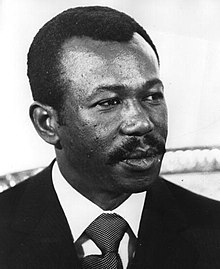
Back Mengistu Haile Mariam Afrikaans መንግስቱ ኃይለ ማርያም Amharic منغستو هيلا مريام Arabic منجستو هيلا مريام ARZ Менгісту Хайле Марыям Byelorussian Менгисту Хайле Мариам Bulgarian মেঞ্জিস্টু হেইল মরিয়াম Bengali/Bangla Mengistu Haile Mariam Breton Mengistu Haile Mariam Catalan Mengistu Haile Mariam Czech
Mengistu Haile Mariam | |
|---|---|
መንግሥቱ ኀይለ ማርያም | |
 Mengistu in 1978 | |
| General Secretary of the Workers' Party of Ethiopia | |
| In office 12 September 1984 – 21 May 1991 | |
| Preceded by | Position established |
| Succeeded by | Position abolished |
| President of Ethiopia | |
| In office 10 September 1987 – 21 May 1991 | |
| Prime Minister | Fikre Selassie Wogderess Hailu Yimenu Tesfaye Dinka |
| Vice President | Fisseha Desta (1987–1991) Tesfaye Gebre Kidan (1991) |
| Preceded by | Himself as Chairman of the Derg |
| Succeeded by | Tesfaye Gebre Kidan (Acting) |
| Chairman of the Derg and Head of State of Ethiopia | |
| In office 17 November 1974 – 28 November 1974 Acting | |
| Preceded by | Aman Mikael Andom |
| Succeeded by | Tafari Benti |
| In office 3 February 1977 – 10 September 1987 | |
| Deputy | Atnafu Abate |
| Preceded by | Tafari Benti |
| Succeeded by | Himself as President |
| Personal details | |
| Born | 21 May 1937[1] Caffa & Ghimirra, Galla-Sidamo Governorate, Italian East Africa[1][2] (now Ethiopia) |
| Political party | Workers' Party of Ethiopia (1984–1991) |
| Spouse | Wubanchi Bishaw[3] |
| Children | 3 |
| Residence(s) | Harare, Zimbabwe |
| Military service | |
| Allegiance | |
| Branch/service | Ethiopian Army |
| Rank | Lieutenant Colonel Commander-in-Chief |
| Battles/wars | 1964 Ethiopian–Somali Border War Ethiopian Civil War Eritrean War of Independence Ogaden War |
Criminal details
| |
| Years active |
|
| Conviction(s) | Genocide (in absentia) |
| Criminal penalty | Life imprisonment (in absentia) Elevated at death penalty (in absentia) |
| Details | |
| Victims | +1,200,000 |
| ||
|---|---|---|
|
leader of Ethiopia 1974–1974, 1977–1987, 1984–1991 (1987–1991)
Government
  |
||
Mengistu Haile Mariam (Amharic: መንግሥቱ ኀይለ ማርያም, pronunciation: [mənɡɨstu haɪlə marjam]; born 21 May 1937) is an Ethiopian former politician and former military officer who was the head of state of Ethiopia from 1977 to 1991 and General Secretary of the Workers' Party of Ethiopia from 1984 to 1991. He was the chairman of the Derg, the Marxist-Leninist military junta that governed Ethiopia, from 1977 to 1987, and the president of the People's Democratic Republic of Ethiopia (PDRE) from 1987 to 1991.[4]
The Derg took power in the Ethiopian Revolution following the overthrow of Emperor Haile Selassie I in 1974, marking the end of the Solomonic dynasty which had ruled Ethiopia since the 13th century. Mengistu purged rivals for power from the Derg and made himself dictator of Ethiopia, attempting to modernize the feudal economy of Ethiopia through Marxist-Leninist-inspired policies such as nationalization and land redistribution. His bloody consolidation of power in 1977–1978 is known as the Ethiopian Red Terror,[5] a brutal crackdown on opposition groups and civilians following a failed assassination attempt by the Ethiopian People's Revolutionary Party (EPRP) in September 1976, after it had ignored the Derg's invitation to join the union of socialist parties. The death toll is unknown but is often estimated at between 30,000 and 750,000.
Internal rebellion, government repression, and economic mismanagement characterized Mengistu's presidency, the Red Terror period being a battle for dominance between the Derg, the EPRP, and their rival the All-Ethiopia Socialist Movement (MEISON), which had initially aligned itself with the Derg. While this internal conflict was being fought, Ethiopia was threatened by both the Somali invasion and the guerrilla campaign of the Eritrean People's Liberation Front, who demanded independence for Eritrea, then a province of Ethiopia. The Ogaden War of 1977–1978 with Somalia, fought over a disputed border region (Ogaden), was notable for the prominent role of Mengistu's Soviet and Cuban allies in securing an Ethiopian victory. The catastrophic famine of 1983–1985 is what brought his government the most international attention.
Mengistu fled to Zimbabwe in May 1991 after the PDRE National Shengo dissolved itself and called for a transitional government. His departure brought an abrupt end to the Ethiopian Civil War. Mengistu Haile Mariam still lives in Harare, Zimbabwe, despite an Ethiopian court verdict which found him guilty of genocide in absentia.[6] Mengistu's government is estimated to be responsible for the deaths of 500,000 to 2,000,000 Ethiopians, mostly during the 1983–1985 famine in Ethiopia.[7][8][9][10]
- ^ a b "Profile: Mengistu Haile Mariam". BBC News. 12 December 2006. Retrieved 13 December 2006.. Other accounts state 21 May 1941 "Эфиопия". Archived from the original on 23 June 2006. Retrieved 21 August 2006., 27 May 1941
- ^ "Mengistu Haile Mariam | president of Ethiopia". Encyclopedia Britannica. Retrieved 7 April 2018.
- ^ "Mengistu Haile Mariam's Biography". Durame News Online. 1 May 2012. Retrieved 6 May 2012..
- ^ "Four facts about Mengistu, the Ethiopian dictator who overthrew Emperor Haile Selassie in 1974". Face 2 Face Africa.
- ^ "Mengistu found guilty of genocide". BBC News. 12 December 2006. Retrieved 8 January 2017.
- ^ "Profile: Mengistu Haile Mariam". BBC News. 12 December 2006. Retrieved 11 January 2007.
- ^ Fitzgerald, Tyrant for the taking in White, Matthew (2011). Atrocitology. Edinburgh: Canongate. p. 615. Retrieved 21 March 2013.
- ^ Rapoport, Knives Are Out in White, Matthew (2011). Atrocitology. Edinburgh: Canongate. p. 615. Retrieved 21 March 2013.
- ^ "Peter Gill, page.44 "Famine and Foreigners: Ethiopia Since Live Aid"" (PDF). Archived from the original (PDF) on 16 May 2018. Retrieved 3 March 2019.
- ^ Giorgis, Dawit Wolde (1989). Red Tears: War, Famine, and Revolution in Ethiopia. Red Sea Press. ISBN 0-932415-34-2.
